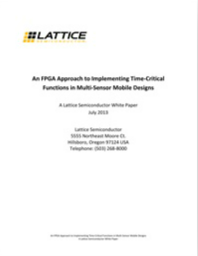An FPGA Approach to Implementing Time-Critical Functions in Multi-Sensor Mobile Designs
Today's massive smartphone market is often depicted as a hotbed of innovation for the continual advancement of cost-effective, power efficient solutions. Whenever smartphone developers need a new function, they inevitably find a way to build it at the lowest cost, using minimal board space and consuming as little power as possible.
The lessons learned in this highly competitive market eventually trickle down to a wider array of mobile applications where the same concepts can be applied once they have been optimized for minimal cost, power and footprint.
Download this whitepaper to learn more.
Read More
By submitting this form you agree to Lattice Semiconductor Corporation contacting you with marketing-related emails or by telephone. You may unsubscribe at any time. Lattice Semiconductor Corporation web sites and communications are subject to their Privacy Notice.
By requesting this resource you agree to our terms of use. All data is protected by our Privacy Notice. If you have any further questions please email dataprotection@techpublishhub.com
Related Categories: Industrial, Power, Processors

More resources from Lattice Semiconductor Corporation
ENABLING MOBILE INTERFACE BRIDGING IN ADAS AND INFOTAINMENT APPLICATIONS
In the automotive market as in all industries, competition breeds innovation. Over the last 100 years, this truth has transformed the horseless car...
Reducing Cost and Power in Consumer Applications Using PLDs
The need to respond to changing market standards in a compressed time to market window has led to the widespread use of programmable logic devices ...
Solving Today’s Interface Challenges With Ultra-LowDensity FPGA Bridging Solutions
Designers are implementing a wide variety of interface bridging solutions that allow them to transfer data across protocols and, in the process, ex...
